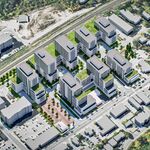But with BRT the capital costs are low enough that a corridor project can be justified even without additional development, right? Don't the numbers on the York BRT project show this?
Again, to add more examples to my point, another 'path of least resistance' project between Point A and Point B. That type of BRT is great when you're shuttling people quickly between points spaced pretty far apart, and serving riders between the points isn't a primary goal.
However, even if that is the case, there is nothing stopping you from keeping minor cross-street intersections within the hydro corridor at-grade, and then putting in a curbside cut-out on the far side of the intersection. This would be no more than your average bus shelter, but you could run a local route in parallel with an express route along the corridor. The Finch Hydro Corridor has between 2 and 4 minor roads passing through it between each major arterial. You could have an express route stopping at only the major arterials (where they build an actual station, along with an under/overpass), and a local route that stops at every street that crosses the corridor, mainly to cater to existing local traffic. Another advantage with this type of configuration is that bus routes can hop on and off the corridor as they please.




